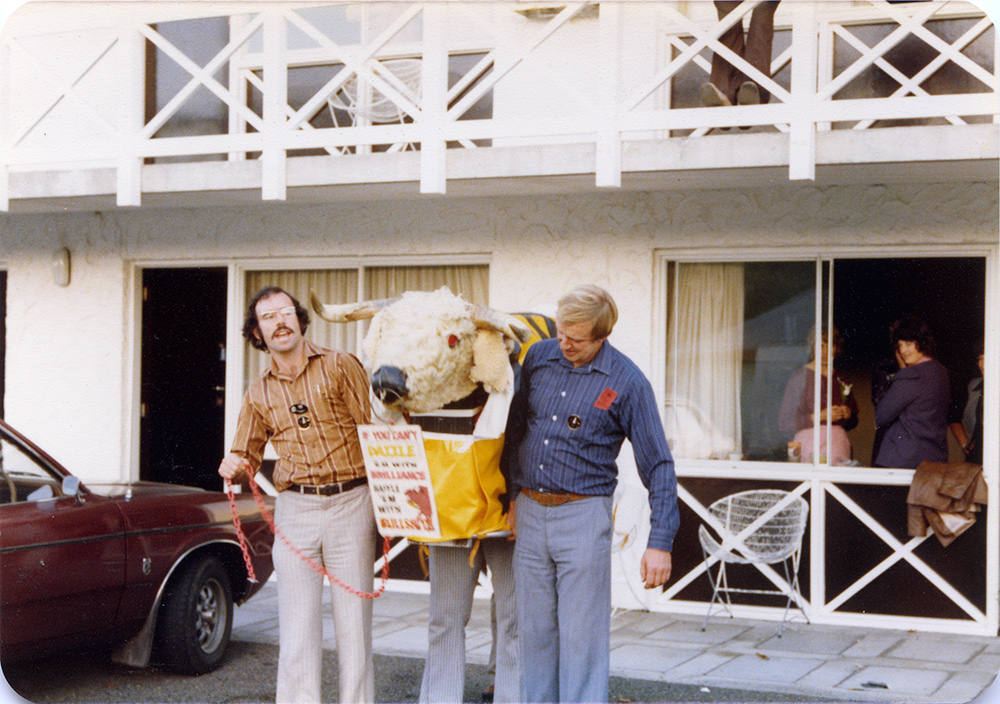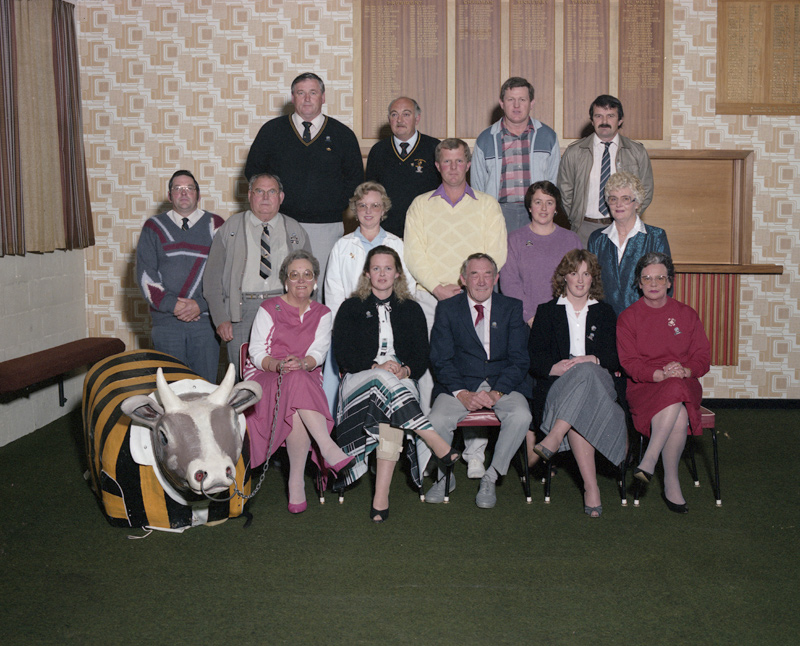


Taranaki rugby mascot Ferdinand the Bull survived one fire, a goring from boar tusks, a broken back and an attack by police. But in the end he became a victim of fashion.
It all began in the early 1950s, when Taranaki supporters decided to challenge Waikato's dairy industry icon. An article published in the Taranaki Rugby Annual 1978-1979 tells the story. It says that in 1952, when the northern foes held the Ranfurly Shield, “Mooloo” the cow was the emblem of Waikato.
In the build-up to the annual game between the rugby rivals, a press item revealed that Mooloo would invade New Plymouth with a procession of decorated cars. A chance remark by a New Plymouth City Council official, that something should be done to thwart the bovine mascot, prompted a few council employees to build a Taranaki gate, which was covered with notices. This was put up across Devon Street to counter the Mooloo attack.
The following year, when Wellington had a short-lived possession of the Ranfurly Shield, the council workers made a bull to take to the capital for Taranaki's attempt to claim the prestigious prize. Murray Mitchell and Geoff Bendall built the bull in Geoff's parent’s garage. "We built it out of straw, number eight wire and papier-mâché” said Mr Mitchell.
And so Ferdinand was born. His first trip out onto Rugby Park, with Mr Mitchell as the back legs and Mr Bendall as the front. It was a rainy day - not ideal for a papier-mâché bull!
"It was pissing down with rain - and the ground was all sloppy. Before we even got out onto the field we'd fallen over" said Mr Mitchell. "We went out and took a bow. The crowd went burko they thought it was wonderful. The guy on the microphone said ‘you’ve heard of Mooloo - well now you've got Ferdinand!'
"Boy we had some fun. Once we thought we'd get smoke coming out his nostrils - you know - to make him look really mean. We took a bee puffer in with us and Geoff was puffing this thing. Next minute he's saying 'Christ man it's not going out his nostrils!' We had to get out of there pretty quick because it was filled with smoke and we were getting asphyxiated!"
On one outing the bull had his back broken - he had been overloaded with half gallon flagons of beer.
Seeing where to go could sometimes be a problem for the men inside - Ferdinand only had two little slits in his chest for the front man to see out of. "Sometimes we had to look to the side and follow the team’s feet, other times we followed the markings on the field - but a lot of the time we just bumbled around banging into things - the crowd thought it was great!"
This first version of Ferdinand lasted around three years before being upgraded. Jimmy Fordie, the manager of a local abattoir preserved a bullocks head and the body was built by local carpenters Jones and Sandford. This version was more robust but he still had a few problems.
The old bull had his back broken for a second time. New Plymouth barber Dave Julian, who spent about 10 years as either the front or back legs of Ferdinand the Bull said after a triumphant Ranfurly Shield match, Ferdinand held three heroes up high. "We took Ross Brown, Peter Burke and John Bayly off the field, there were three of us under the bull in those days, and we all came out very bandy legged. At that time his back was broken, so Ross Brown took the bull down to his workshop and put in a new backbone for us. It was a lot heavier and bigger than it was originally and we had to wear crash helmets underneath to stop hitting our heads."
Mr Julian also has memories of three marauding King Country supporters. "We had finished doing all our stuff and we were just parading around the ground and put the ball down and next thing these three supporters from King Country came over the fence, with boars' heads stuck on placards, complete with tusks. They started ripping hell out of the bull, so we had a scrap. But we were sober and they were drunk and we won no problem. Then the cops came down and threw them out of the ground, placards and all. They just wanted to know were we all right? We said 'Yeh'. They said 'Thanks for doing a good job' and they took off."
A trip to the Waikato in the late 1950s was also colourful. "When we went up to Hamilton for that match there, we didn't know what to do with him, so we took him to the police station and they looked after him for us" Mr Julian says.
Overnight, the police officers revealed their true colours. "When we went to get him the next morning he was painted the Waikato colours." A stripe of red had been added to Ferdinand's gold and black coat. "We had to wash it all off and get it spruced up," Mr Julian says.
On home ground, Ferdinand was a hero, who appeared in cartoons, wooed the crowds and led parades through town before games. Mr Julian says those parades began at the State Hotel on the corner of Robe Street and Devon Street East, followed a circuit through the city finishing back at the State.
Later, when Rugby Park was packed for the match, Taranaki's mascot would arrive in style. "That was absolutely fantastic. You could hear the buzz of the crowd a quarter of a mile away" he says. "You would be up at the gate and Ferdie's head would be peeking out over the top of the cab of the truck and the roar was going. Quite often we would have to wait for the gates to be open and you would let it roar and go through the gates, well the crowd just erupted. You have no idea. It was just fantastic."
Taranaki Rugby Supporters Club president Stewart Erb was a boy during that early Ranfurly Shield era and clearly remembers the antics of the big bull. "He used to stand on the side-line with the people that operated him until two to three minutes before the end of the game. He bowed to the crowd and he always got a fantastic reaction, especially in those early days. People used to yell and clap" Mr Erb says. “He used to go and scratch his back against the goalposts like you see bulls doing in the paddock… In the latter years, it was the children that enjoyed him possibly more than the older generation".
Mr Julian is philosophical about Ferdie being put out to pasture. "He had his day and you must move with the times. All the other clubs were getting two-legged mascots." The thirst version of Ferdinand, worn by Morris West, pranced on to the field for the first time on 24 August 2002, for the inaugural match played in the revamped Rugby Park, now called Yarrow Stadium.
The upright mascot helped the Amber and Blacks to a 36-30 victory over Otago in the National Provincial Competition.
Puke Ariki Heritage Collection: Virginia Winder talks to Stewart Erb about Ferdinand the Bull
LinkPuke Ariki Heritage Collection: Ferdie’s Helpers costume
LinkPuke Ariki Heritage Collection: Ferdinand Club armband
LinkPuke Ariki Heritage Collection: Ferdinand Club badge
LinkPuke Ariki Heritage Collection: Records of the Ferdinand Club
LinkPlease do not reproduce these images without permission from Puke Ariki.
Contact us for more information or you can order images online here.